[Solved] First Steps Section Quickly Cover Lay Ground Work Class Read Caution 1 Create Header File Q37181549
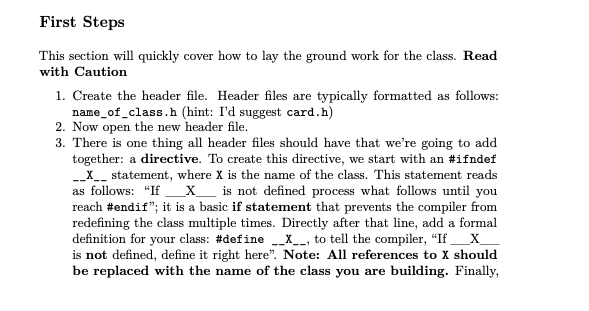
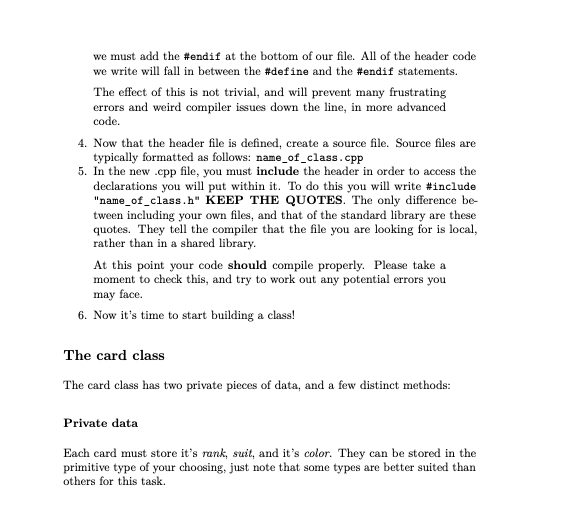
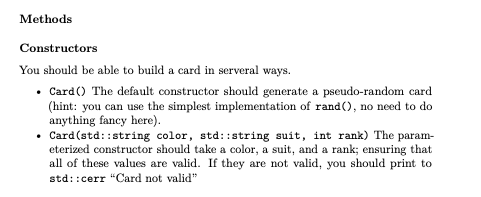

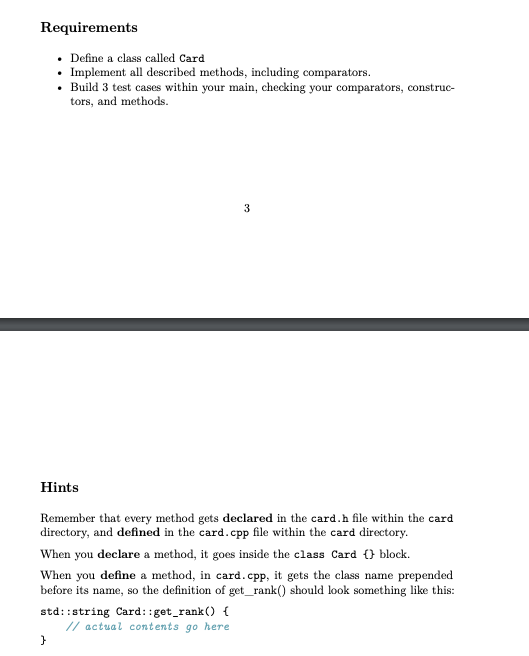
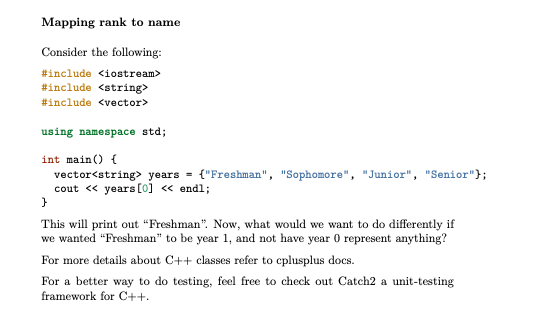
First Steps This section will quickly cover how to lay the ground work for the class. Read with Caution 1. Create the header file. Header files are typically formatted as follows name_of_class.h (hint: I’d suggest card.h) 2. Now open the new header file 3. There is one thing all header files should have that we’re going to add together: a directive. To create this directive, we start with an #ifndef X statement, where X is the name of the class. This statement reads as follows: “If Xis not defined process what follows until you reach #endif”, it is a basic if statement that prevents the compiler from redefining the class multiple times. Directly after that line, add a formal definition for r class: #define-X-, to tell the compiler, “If–X is not defined, define it right here”. Note: All references to X should be replaced with the name of the class you are building. Finally, we must add the #endif at the bottom of our file. All of the header code we write will fall in between the #define and the #end if statements. The effect of this is not trivial, and will prevent many frustrating errors and weird compiler issues down the line, in more advanced code. 4. Now that the header file is defined, create a source file. Source files are typically formatted as follows: name_of_class.cpp 5. In the new .cpp file, you must include the header in order to access the declarations you will put within it. To do this you will write #include “name_of_class.h” KEEP THE QUOTES. The only difference be- tween including your own files, and that of the standard library are these quotes. They tell the compiler that the ile you are looking for is local rather than in a shared library. At this point your code should compile properly. Please take a moment to check this, and try to work out any potential errors you may face. 6. Now it’s time to start building a clas! The card class The card class has two private pieces of data, and a few distinct methods: Private data Each card must store it’s rank, suit, and it’s color. They can be stored in the primitive type of your choosing, just note that some types are better suited thain others for this task. Methods Constructors You should be able to build a card in serveral ways. . Card) The default constructor should generate a pseudo-random card (hint: you can use the simplest implementation of rand), no need to do anything fancy here) Card (std: :string color, std: :string suit, int rank) The param eterized constructor should take a color, a suit, and a rank; ensuring that all of these values are valid. If they are not valid, you should print to std::cerr “Card not valid These are the only two constructors you must implement. If a user passes in only 2/3 of these parameters your class must default the other values to either a random value, or a value of your choosing std: :string get_suit) Returns the suit of the card in a human-readable format: “Dind”, “Club’ “Heart “Spade” std: :string get color ) Returns the color of the card in a human-readable format: “Red”, “Black std::string get_rank() Returns the rank of the card in a human-readable format: “Ace”, “2”, “3”, .。. “10”, “Jack”, “Queen”, “King” Comparators The ability to compare cards based on rank, with ace being low (represented as 1). You should be able to compare whether cards are less than, equal to, greater than, or not equal to eachother based on their rank. This will mean overloading certain operators. Remember from lecture that we can overload an operator as follows. Suppose we wanted to overloadfor cards, to instead compare based on suit: bool operator-(Card ci, Card c2) t return d1.get_suit)d2.get_suitO Though remember that we want to compare on rank, not suit. So your code will be different Requirements . Define a class called Card Implement all described methods, including comparators Build 3 test cases within your main, checking your comparators, construc- tors, and methods. Hints Remember that every method gets declared in the card.h file within the card directory, and defined in the card.cpp file within the card directory When you declare a method, it goes inside the class Card block. When you define a method, in card.cpp, it gets the class name prepended before its name, so the definition of get rank() should look something like this: std: :string Card: : get_rank)( // actual contents go here Mapping rank to name Consider the following: #include <iostream> #include <string> #include <vector> using namespace std; int mainO {“Freshman”, “Senior”); “Sophomore”, “Junior”, vector<string> years = cout < years << endl; This will print out “Freshman”. Now, what would we want to do differently if we wanted “Freshman” to be year 1, and not have year 0 represent anything? For more details about C++ classes refer to cplusplus docs. For a better way to do testing, feel free to check out Catch2 a unit-testing framework for C++ Show transcribed image text First Steps This section will quickly cover how to lay the ground work for the class. Read with Caution 1. Create the header file. Header files are typically formatted as follows name_of_class.h (hint: I’d suggest card.h) 2. Now open the new header file 3. There is one thing all header files should have that we’re going to add together: a directive. To create this directive, we start with an #ifndef X statement, where X is the name of the class. This statement reads as follows: “If Xis not defined process what follows until you reach #endif”, it is a basic if statement that prevents the compiler from redefining the class multiple times. Directly after that line, add a formal definition for r class: #define-X-, to tell the compiler, “If–X is not defined, define it right here”. Note: All references to X should be replaced with the name of the class you are building. Finally,
we must add the #endif at the bottom of our file. All of the header code we write will fall in between the #define and the #end if statements. The effect of this is not trivial, and will prevent many frustrating errors and weird compiler issues down the line, in more advanced code. 4. Now that the header file is defined, create a source file. Source files are typically formatted as follows: name_of_class.cpp 5. In the new .cpp file, you must include the header in order to access the declarations you will put within it. To do this you will write #include “name_of_class.h” KEEP THE QUOTES. The only difference be- tween including your own files, and that of the standard library are these quotes. They tell the compiler that the ile you are looking for is local rather than in a shared library. At this point your code should compile properly. Please take a moment to check this, and try to work out any potential errors you may face. 6. Now it’s time to start building a clas! The card class The card class has two private pieces of data, and a few distinct methods: Private data Each card must store it’s rank, suit, and it’s color. They can be stored in the primitive type of your choosing, just note that some types are better suited thain others for this task.
Methods Constructors You should be able to build a card in serveral ways. . Card) The default constructor should generate a pseudo-random card (hint: you can use the simplest implementation of rand), no need to do anything fancy here) Card (std: :string color, std: :string suit, int rank) The param eterized constructor should take a color, a suit, and a rank; ensuring that all of these values are valid. If they are not valid, you should print to std::cerr “Card not valid
These are the only two constructors you must implement. If a user passes in only 2/3 of these parameters your class must default the other values to either a random value, or a value of your choosing std: :string get_suit) Returns the suit of the card in a human-readable format: “Dind”, “Club’ “Heart “Spade” std: :string get color ) Returns the color of the card in a human-readable format: “Red”, “Black std::string get_rank() Returns the rank of the card in a human-readable format: “Ace”, “2”, “3”, .。. “10”, “Jack”, “Queen”, “King” Comparators The ability to compare cards based on rank, with ace being low (represented as 1). You should be able to compare whether cards are less than, equal to, greater than, or not equal to eachother based on their rank. This will mean overloading certain operators. Remember from lecture that we can overload an operator as follows. Suppose we wanted to overloadfor cards, to instead compare based on suit: bool operator-(Card ci, Card c2) t return d1.get_suit)d2.get_suitO Though remember that we want to compare on rank, not suit. So your code will be different
Requirements . Define a class called Card Implement all described methods, including comparators Build 3 test cases within your main, checking your comparators, construc- tors, and methods. Hints Remember that every method gets declared in the card.h file within the card directory, and defined in the card.cpp file within the card directory When you declare a method, it goes inside the class Card block. When you define a method, in card.cpp, it gets the class name prepended before its name, so the definition of get rank() should look something like this: std: :string Card: : get_rank)( // actual contents go here
Mapping rank to name Consider the following: #include #include #include using namespace std; int mainO {“Freshman”, “Senior”); “Sophomore”, “Junior”, vector years = cout
Expert Answer
Answer to First Steps This section will quickly cover how to lay the ground work for the class. Read with Caution 1. Create the he… . . .
OR

